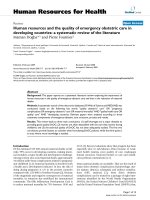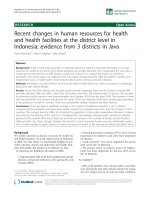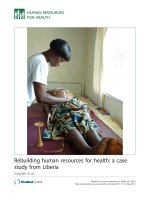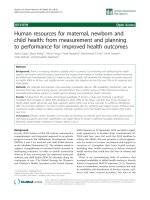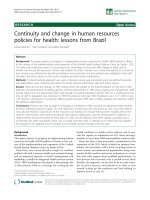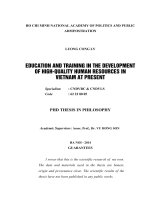Human resources quality improvement from
Bạn đang xem bản rút gọn của tài liệu. Xem và tải ngay bản đầy đủ của tài liệu tại đây (649.78 KB, 20 trang )
Management
2022
Vol. 26, No. 1
DOI: 10.2478/manment-2019-0088
NGUYEN DAT MINH
NGUYEN THI HANH QUYEN
Human resources quality
improvement from the
perspective of Kaizen
practices
1. Introduction
Nguyen Dat Minh, Ph.D.,
Faculty of Industrial and Energy
Management, Electric Power
University, Hanoi, Vietnam,
ORCID: 0000-0002-2267-4917.
Nguyen Thi Hanh Quyen, Msc,
Center for Vietnam Science and
Technology Internationalization
Promotion, Ministry of Science and
Technology, Vietnam,
ORCID: 000-0002-0828-6213.
Human being or human resource is defined
as an organization’s most valued assets of
the people working there who contribute to
the achievement of its objectives (Amstrong,
2008). Therefore, managers pay more
attention to human resource development
to achieve sustainability. Human resource
helps organizations develop their workforce
through employee training and career
development which improves organizational
effectiveness and performance (Wilson,
2005). The core factor of human resources
quality improvement is the growth or
realization of a person’s ability and thinking,
through conscious or unconscious learning.
Development programs usually include
elements of planned study and experience
and are frequently supported by a coaching or
counseling facility (Wilson, 2005).
In Japanese, Kaizen means “small,
incremental,
continuous
improvement”
(Prosic, 2011). Kaizen or Continuous
Improvement (CI) is a means of continuous
improvement in personal life, home life,
social life, and working life. At the workplace,
Kaizen means continuing improvement
144
Management
2022
Vol. 26, No. 1
involving everyone – managers and workers alike (Masaaki, 1986). Kaizen
is a philosophy in the Lean system that focuses both on the process and the
results. It is a process that, when done correctly, humanizes the workplace,
eliminates unnecessarily hard work (both mental and physical), teaches people
how to do rapid experiments using scientific methods, and how to eliminate
waste in business processes (Prosic, 2011). The Kaizen methodology is a system
for communicating ideas throughout the company hierarchy, encouraging
everyone to seek and exploit new opportunities and dismantling barriers to
information flow (Rosak Szyrocka, 2017). Kaizen involves setting standards and
then continually improving those standards. To support the higher standards,
Kaizen also involves providing the training, materials, and supervision that is
needed for employees to achieve higher standards and maintain their ability to
meet those standards on an on-going basis (Prosic, 2011). Kaizen promotes small
improvements, not big improvements to make rapid change. This mindset helps
enterprises achieve their goals by gradual improvements from solving small
problems to create bigger improvements. Meanwhile, it is a long-term process of
human development; and it is a continuous process to enhance human abilities
(Liker, 2004; Masaaki, 1986).
Therefore, Kaizen’s philosophy is an effective method to develop human
resources (Farris, Van Aken, Doolen, & Worley, 2009; Glover, Farris, Van Aken,
& Doolen, 2011). Previous studies recognized the importance of the human
aspect of a Lean system in general, considering both the management and
the workforce (Arezes, Dinis-Carvalho, & Alves, 2015; Gaiardelli, Resta, &
Dotti, 2019). However, while Lean proponents argue that lean workers show
an intrinsically motivated behavior and appear more productive, leading to
improved operational performance (Gaiardelli et al., 2019), Lean opponents
suggest that workers operate in limiting and alienating conditions that create
a dependent and deskilled workforce (De Treville & Antonakis, 2006). Besides,
most of the research focusing on the relationship between Lean and human
aspects (Gaiardelli et al., 2019), human resource management to conducting
Lean practices (Vukadinovic, Macuzic, Djapan, & Milosevic, 2019), whereas
human development aspects during Lean implementation are often neglected or
partially considered (Yang, Yeh, & Yang, 2012).
Therefore, to fill the gap of linking between Kaizen practices, performance
improvement, and operational workers development, this paper presents
a new approach to human resources quality improvement orientation under
the Kaizen practices to improve work performance through day-by-day Kaizen
implementing.
145
NGUYEN DAT MINH
NGUYEN THI HANH QUYEN
Management
2022
Vol. 26, No. 1
2. Literature review
2.1. Kaizen – Continuous Improvement
Kaizen is a strategy normally adopted by a company where teams of employees
at various levels through the cross-functional effort with collective talents within
the company work together proactively on improving specific areas within the
company (Maarof & Mahmud, 2016). Everyone is encouraged to come up with
small improvement suggestions on a regular basis (Masaaki, 1986; Prosic, 2011;
Suárez‐Barraza, Ramis‐Pujol, & Kerbache, 2011).
According to (Masaaki, 1986), Kaizen is a continuous improvement process
involving everyone, managers and workers alike. Broadly defined, Kaizen is
a strategy to include concepts, systems and tools within the bigger picture of
leadership involving and people culture, all driven by the customer. Womack
and Jones refer to Kaizen as a lean thinking and lay out a systematic approach
to help organizations systematically to reduce waste. They describe waste as any
human activity that absorbs resources but creates or adds no value to the process
(Womack & Jones, 2003).
Kaizen concept uses the Lean Management approach to eliminate non-valueadded processes as well as promotes creating good change (Rosak Szyrocka,
2017). Kaizen practices have been widely reported to produce positive changes
in business results and human resource outcomes (Glover et al., 2011). Kaizen
is an ongoing methodology and philosophy for challenging and empowering
everyone in the organization to use their creative ideas to improve their daily
work and this approach did not focus on the big change in a short time, but it is
a small, low-cost, low-risk improvement that can be easily implemented (Lolidis,
2006). Kaizen is a method and philosophy to promote and empower everyone
in the organization to use their creative ideas to improve their daily work
(Rosak Szyrocka, 2017). Kaizen results in improved productivity and quality,
better safety, faster delivery, lower costs, and greater customer satisfaction.
Furthermore, employees find work to be easier and more enjoyable resulting in
higher employee morale and lower turnover (Prosic, 2011). The overviews and
principles in promoting Kaizen are:
• changes and improvements are continuous and long-term,
• there are no bad ideas and all ideas are well-received,
• all decisions are made based on actual production and knowledge,
• everyone thinks, learns, and changes together,
• it is necessary to establish a general rule for an effective workplace,
• it is necessary to build team spirit and cultures of cooperation.
146
Human resources quality improvement
from the perspective of Kaizen practices
Management
2022
Vol. 26, No. 1
In essence, Kaizen mainly focuses on changing people’s habits to achieve
the following results: (1) Promoting human creative thinking to find new
approaches, (2) Career skills development, (3) Discipline and principle
compliance, (4) Problem-solving ability, and (5) Teamwork skills and
information sharing (Liker, 2004; Masaaki, 1986; Ohno, 1988; Rosak Szyrocka,
2017; Skrzypek, 2010). These processes have been continuously carried out on
the whole enterprise long enough to form an organizational culture - Kaizen
culture. Thus, Kaizen is one of the best methods to improve both operational
performance, employee outcomes (Gaiardelli et al., 2019). Besides, Kaizen
creates an atmosphere conducive to problem-solving through collaboration
(Rosak Szyrocka, 2017), this leads to the sustainable improvement of human
resources.
2.2. Kaizen practice and human resources quality improvement
Human resource can be viewed as encompassing and we can defining human
resource in the organization as concerns the increasing decentralization or
devolution of practices related to obtaining, training, developing, maintaining,
and sustaining a competent workforce (Jørgensen, Laugen, & Boer, 2007). There
is various research in the literature that links Kaizen practices and human
improvement that focus on the human resource policies and the impact that
Kaizen implementation has on employees behavior and their operational
performance (Conti, Angelis, Cooper, Faragher, & Gill, 2006; Martínez-Jurado,
Moyano-Fuentes, & Jerez-Gómez, 2014).
From the perspective of Lean production, human improvement and Kaizen
practice have a very close linkage (Farris et al., 2009; Glover et al., 2011; Jørgensen
et al., 2007; Malloch, 1997; Martínez-Jurado et al., 2014; Prosic, 2011; Rosak
Szyrocka, 2017). The linking between human improvement in the context of
Kaizen practice, such as selection, training, appraisal, compensation, job design,
and employee involvement, lead to increasing job motivation, commitment,
cooperation, involvement, flexibility, organizational citizenship, reduced
turnover, and absenteeism (Jørgensen et al., 2007).
The Kaizen characteristics are group design, task force design, continuous
problem solving, day-by-day improvement, creative thinking, information
sharing, and work discipline (Farris et al., 2009; Glover et al., 2011). The Kaizen
characteristics that may impact Kaizen practices outcome were measured goal
clarity, team functional, management support, and continuous thinking. As
a result, the Kaizen practice outcome can lead to human improvement which
147
NGUYEN DAT MINH
NGUYEN THI HANH QUYEN
Management
2022
Vol. 26, No. 1
measured work expertise and experience, creative thinking, planning capability,
project controlling, learning behavior, changing acceptance, and awareness
enhancement (Gibb, 2016; Glover et al., 2011; Jørgensen et al., 2007).
Human resource development is related to the concepts of education, training,
and development. These elements of human resource development are closely
related to learning at work (Gibb, 2016). Human skills and thinking often come
after a period of practice and then transfer into knowledge. In other words,
human development and knowledge development follow the rule “from vivid
intuition to abstract thinking” (Amstrong, 2008; Gibb, 2016; Jørgensen et al., 2007;
Martínez-Jurado et al., 2014). Besides, human resource development relates to
theoretical education (Armstrong & Taylor, 2020; Gibb, 2016), on-the-job training
- OJT (Jain, 1999), and work experience accumulation (Armstrong & Taylor, 2020;
Garavan, Morley, Gunnigle, & Collins, 2001). OJT as an informal type of training
given at the employee’s workplace, where the trainer plays the role of the
immediate supervisor of the employee (Siele, 1990) and OJT was claimed to be
the most common, the most widely accepted, and the most necessary method of
training employees in the skills essential for acceptable performance (Jain, 1999).
The purpose of OJT is to improve the employee’s working skills, efficiency, and
productivity through day-by-day practice (Siele, 1990). Therefore, the purpose of
OJT can be achieved from the perspectives of Kaizen.
In summary, although much of research indicated the positive relationship
between Lean/Kaizen practices and human resources quality improvement,
most of these studies are focusing on the impact of human resource development
on Lean/Kaizen practice outcome (Conti et al., 2006; Prosic, 2011; Suárez‐Barraza
et al., 2011; Wilson, 2005). This paper aims at exploring the impact of Kaizen
practices through day-by-day Kaizen implementing on human resources quality
improvement, considering both team members and team managers in the case
study.
Based on these mentioned, the following research hypotheses are:
• Kaizen practices have a direct relationship to operational outcome,
• Kaizen practices have a direct relationship to human resource quality outcome.
3. Research methodology
3.1. Data collection
This paper is based on an in-depth exploratory case study conducted in six
Vietnamese manufacturing enterprises. All the private-owned case companies
148
Human resources quality improvement
from the perspective of Kaizen practices
Management
2022
Vol. 26, No. 1
are small and medium enterprises (SMEs) and operating in the plastic industry.
The multiple case studies are considered to build a more robust theory (Yin,
2013). Indeed, by using multiple case studies, it is possible for researchers
to learn more about cause and effect relationships and make connections in
a clearer manner (Gaiardelli et al., 2019; Yin, 2013). The present study uses
a qualitative method included open-end interview, observation, participant
observation, and analysis of responses to open-end items on the questionnaire
(Kaplan & Duchon, 1988).
The qualitative data provides a deep understanding of survey responses and
provides a detailed assessment of patterns of responses. Moreover, a process
approach was adopted to trace the changes in human capacity development
and operational performance. In particular, two time periods were identified:
(1) the first phase of Kaizen project implementation and (2) after Kaizen project
conducted.
The authors conducted research on each enterprise in a Kaizen project over
a period of four to eight months through the method of interview, observing
and participant observation in Kaizen groups in the enterprise. All the group
members who experience all the Kaizen projects were included in sample
and evaluated the human development changes before and after participated
Kaizen projects. Besides, all Kaizen projects from six case company are
conducted in the same way to ensure the significance of study results,
including:
1. Declare the establishment of Kaizen improvement team and identify members’
missions.
2. Training to Kaizen team members on ideas and steps to implement a Kaizen
project in the same way.
3. Conduct field investigation and collect data at selected production areas.
4. Have daily meeting among term members and weekly meeting to report to
superiors and high-level leaders.
5. All project information is visualized in the Kaizen room, everyone can see
and read the situation and progress.
Evaluation criteria for human resources quality improvement through
Kaizen are selected and summarized based on the results of previous
research on Kaizen and human resources development (Gibb, 2016; Liker,
2004; Masaaki, 1986; Rosak Szyrocka, 2017; Skrzypek, 2010). Accordingly,
six criteria belonging to two groups related to capability development and
awareness development are developed by the authors as shown in table 1
below.
149
NGUYEN DAT MINH
NGUYEN THI HANH QUYEN
Management
2022
Vol. 26, No. 1
Table 1. Evaluation criteria for human development from Kaizen approach
Dimension
Criteria
Capability development
1. Expertise improvement
2. Management capability and job assignment improvement
3. Problem solving abilities
Awareness and personality
development
4. Creative thinking and idea suggestion abilities
5. Discipline and rules compliance
6. Cooperation and information sharing skills
Source: the authors summarized and selected from several research
Evaluation of human development is based on 5-point scale with performances
as shown in table 2 below.
Table 2. 5-point scale for human development assessment from Kaizen approaching
Score
No.
Criteria
1
2
3
4
5
1
Expertise improvement
Cannot
operate the
job independently
Can operate the job
under supervision
Understand
and can
operate the
job independently
Understand,
operate independently,
and cooperate within the
processes
Understand,
operate independently,
cooperate,
and training
to other members
2
Management
capability
and job assignment
improvement
Inability to
manage the
tasks in the
team
Can manage the
tasks under
instruction
Can manage
the tasks but
cannot assign the tasks
within team
Can manage
and assign
the tasks
within team
Can manage,
assign the
tasks, and
make consensus within
team
3
Problem solv- Inability to
ing abilities
solve the
problems
occur during
the project
Can solve
the problems under
instruction
Can solve
the problems
follow the
process
Proactive
and flexible
in problem
solving
Proactive, flexible, and can
propose better
processes
150
Human resources quality improvement
from the perspective of Kaizen practices
Management
2022
Vol. 26, No. 1
4
Creative
thinking and
idea suggestion abilities
Have no any Capability
Can propose
idea and
to do the
some good
proposal
ideas but
ideas
not propose
ideas yet
Can propose Can propose
good and cre- good and
ative ideas
creative ideas
regularly and
share to others
5
Discipline
and rules
compliance
No discipline and
rules compliance
Discipline
Discipline
and rules
and rules
complicompliance
ance under
control and
supervision
Discipline
and rules
compliance
proactively
Proactive in
discipline,
rules compliance, and
prompt other
members
6
Cooperation
and information sharing
skills
No cooperation and
share the
information
Cooperation if
required, no
information
sharing
Cooperation
and share the
information
proactively
Cooperation
and share the
information
proactively
and clearly
Cooperation
and share the
information
within team
Source: the authors developed from (Amstrong, 2008; Farris et al., 2009; Jørgensen et al., 2007; Liker,
2004; Masaaki, 1986; Ohno, 1988; Prosic, 2011; Rosak Szyrocka, 2017; Skrzypek, 2010; Wilson, 2005)
3.2. Data analysis
During the study, all the documents from manager interviews and team
observation were used to analyze the data. The data analysis is to identify how
Kaizen projects impact operational performance and human development.
A total of 28 operational workers and 5 Kaizen team leaders from six
companies participated in the study. Most of the study participants came
from production department and training team belongs to HR department,
they had a normal 8 working hours per shift from Monday to Saturday. The
average age of participants is under 31 years old, ranged between 20 and
41 years old. The job experience of the respondents ranged between 2 and
10 years. A total of 30 percent of the participants has university degree and
above. Table 3 presents case study profile, demographic and job characteristics
of the participants.
151
NGUYEN DAT MINH
NGUYEN THI HANH QUYEN
Management
2022
Vol. 26, No. 1
Table 3. Case study profile and participants information
Company profile
Main products
No. of employee
Duration of Kaizen participated
Hanoi plastic
Automotive plastic parts
180
From 4.2019 to 11.2019
Haplast
Plastic bags and package
125
From 6.2020 to 9.2020
TuanHuyen
Plastic bags and food
wraps
25
From 11.2020 to 3.2021
TayDo Plastics
Construction plastic materials, plastic pipes
160
From 4.2020 to 9.2020
VietDuc
Plastic bags
156
From 8.2020 to 12.2020
DucHieu
Plastic packages
135
From 4.2020 to 7.2020
Demographic and job characteristics
No.
Percentage
21
12
64%
36%
Under 20
20 – 30
31 – 40
41 - 50
0
15
16
2
0%
45%
48%
7%
Job experience
Under 3 years
3 – 5 years
Higher 5 years
6
13
14
18%
39%
43%
Qualification
High school
College
University and higher
7
16
10
21%
48%
31%
Department
Production
HR
Logistics and warehouse
Other
18
10
0
5
54%
31%
0%
15%
Kaizen experience
Yes
No
18
15
55%
45%
Gender
Male
Female
Age
Source: own study
152
Human resources quality improvement
from the perspective of Kaizen practices
Management
2022
Vol. 26, No. 1
To analyze the data from documents, the open-end interview has first been
conducted with Kaizen project managers to explore the baseline of team
members capability. Observing and participant observation conducted during
the Kaizen projects occurs from the kick-off meeting to final report meeting in
each case company to take a note of human capability improvement between
team members. For each item was mentioned in table 2, responses were analyzed
using mean-score values. The achieved results from observation combined with
findings from interview were used to explore the relationship between human
factors improvement and the Kaizen practices and their impacts on operational
performance.
4. Results
4.1. Operational outcome
The results outcome of Kaizen is explained by four main criteria, including: (1)
Productivity, (2) Quality, (3) Cost, and (4) Delivery. These criteria are considered
as the most important outcomes to determine that the implementing Kaizen
(Pascal, 2007; Womack & Jones, 2003). The results are summarized as shown in
table 4 below.
Table 4. Kaizen results from case companies
Case
company
Kaizen outcome criteria
Productivity
Hanoi plastic Reduce manpower in
Production line No.1
from 6 workers to 5
workers
Quality
Cost
Reduce 32%
of defective
Reduce lead time
from 1087 sec to 970
sec
Delivery
Improve on-time
delivery to next
processed to 94%
Haplast
Production efficiency
increased from 73.7%
to 89.2%
n.a
Reduce W.I.P from 15 n.a
pieces to 5 pieces
TuanHuyen
Increase production
volume from 300 kg
PE per shift to 420 kg
PE per shift
Reduce 100%
defectives
related to
product
weight after
setup Pokayoke
Reduce production
n.a
lot size from 250 kg
(10 packages) to 50 kg
(2 packages)
153
NGUYEN DAT MINH
NGUYEN THI HANH QUYEN
Management
2022
Vol. 26, No. 1
TayDo
Plastics
Reduce manpower in
cutting process from 3
workers to 2 workers
while keep production
volume
Reduce
defects in
print process
from 510 m/
order to 306
m/order
Reduce modelchange time from
69 minutes to 42
minutes
Reduce process
distance from
3451.9 m/shift to
429.66 m/shift
VietDuc
Increase 15%
production volume
after change the diechange method
Eliminate
wrong
product
grade in
packing
process after
conducted
visualize and
5S
n.a
n.a
DucHieu
Improve OEE from
16% to 49% in Cutting
line.
Reduce NG
Reduce lead time
ratio from
from 1143 sec to
2.4% to 1.65% 748 sec (Product
No.H572-1)
Reduce material
supply time from 4
minutes/lot to 2.9
minutes/lot
Reduce energy
consumption 320
USD/month
Source: own study
The results showed positive improvements in all of the selected enterprises
after the Kaizen projects ended. With regard to Hanoi Plastics, the most striking
result is a reduction in important resources like human resources and lead time
although production output did not grow up (keeping the same output of 400
products/line per day). Haplast and TuanHuyen had better results with a rise in
productivity and production efficiency, but a decline in the number of employees
and lead time. The Kaizen project of TayDo was successful in decreasing model
change and defective ratio, while still increasing productivity. For Export
VietDuc, the good result was recorded on criteria for die-change and mistakeproofing, but the result of production cost and delivery were not calculated due
to an enormous variety of products in the selected production line and a change
in the production schedule. DucHieu is the most successful and all the criteria
were fully recorded. The OEE (Overall Equipment Effective) increase from 16%
to 49% in the cutting line, while reducing NG (not good) ratio, lead time, delivery
time, and energy consumption.
154
Human resources quality improvement
from the perspective of Kaizen practices
Management
2022
Vol. 26, No. 1
In conclusion, all the values reported in table 4 are positive, demonstrating that
Kaizen contributes to achieving production performance, although the level of
improvement is different between cases.
4.2. Human resources quality improvement
With the aim of evaluating changes in terms of human development, the
evaluation criteria for team members in six case studies are carried out during
the whole time of Kaizen projects from the beginning to the end. The authors
attended all meetings of the Kaizen improvement teams and recorded data
carefully. The capability assessment results (scores of team members were
calculated on average) were categorized into levels of the job titles, including
assembly supervisor, team leaders, team members as illustrated in figure 1.
As reported from figure 1 to figure 6, during the Kaizen conducting, in the first
month, the human outcome assessment seems worse. However, after completed
the projects most of the criteria had increased.
Firstly, Hanoi Plastics established the Kaizen team include 6 members
and 1 manager. The average score of six human factors improvement after
conducted the Kaizen project was increased (Expertise mean score +0.6 from
3.0 to 3.6; Management capability and job assignment improvement mean score
+ 1.0 from 2.1 to 3.1; Problem-solving ability mean score + 0.9 from 2.4 to 3.3;
Creative thinking and idea suggestion ability mean score +1.1 from 2.3 to 3.4;
Discipline and rules compliance mean score + 1.7 from 1.4 to 3.1; Cooperation
and information sharing skills mean score + 0.9 from 1.7 to 2.6).
Figure 1. Human development in Hanoi Plastics
Source: own study
155
NGUYEN DAT MINH
NGUYEN THI HANH QUYEN
Management
2022
Vol. 26, No. 1
Secondly, Kaizen team in Haplast has started from the first day of June 2020
to conduct the Kaizen project for the production line. A production supervisor
and 5 team leaders are selected to join the task. The average score of six human
factors improvement after conducted the Kaizen project was significant
increased (Expertise mean score +0.6 from 2.2 to 2.8; Management capability and
job assignment improvement mean score + 1.3 from 2.0 to 3.3; Problem-solving
ability mean score + 0.8 from 3.0 to 3.8; Creative thinking and idea suggestion
ability mean score +1.5 from 3.0 to 4.5; Discipline and rules compliance mean
score + 1.3 from 2.0 to 3.3; Cooperation and information sharing skills mean
score + 0.6 from 3.2 to 3.8).
Figure 2. Human development in Haplast
Source: own study
Thirdly, TuanHuyen company has assigned 4 workers join the Kaizen team
under the leadership of director directly. The average score had recorded
from 11/2020 to 1/2021 are following (Expertise mean score +0.6 from 3.0 to
3.6; Management capability and job assignment improvement mean score
+ 1.0 from 2.2 to 3.2; Problem-solving ability mean score + 0.6 from 2.6 to 3.2;
Creative thinking and idea suggestion ability mean score +1.8 from 1.6 to 3.4;
Discipline and rules compliance mean score + 2.0 from 1.8 to 3.8; Cooperation
and information sharing skills mean score + 1.2 from 1.6 to 2.8).
156
Human resources quality improvement
from the perspective of Kaizen practices
Management
2022
Vol. 26, No. 1
Figure 3. Human development in TuanHuyen
Source: own study
Fourthly, TayDo top management has assigned one Group leader and 4 team
members involved in Kaizen projects in the whole company. After scored six
indicators one by one, the “Discipline and rules compliance” factor got the
highest change with +1.2 from 2.4 to 3.6; next is “Management capability and
job assignment improvement”, “Problem solving ability”, and “Cooperation and
information sharing skills” with + 0.8 score. The factor “Expertise” and “Creative
thinking and idea suggestion ability” got +0.6 and +0.4 from 3.2 to 3.6 and 2.4 to
3.0.
Figure 4. Human development in TayDo plastics
Source: own study
157
NGUYEN DAT MINH
NGUYEN THI HANH QUYEN
Management
2022
Vol. 26, No. 1
Fifthly, All of Kaizen team in DucHieu plastics come from Lean department
and most of them have experience in Kaizen. Therefore, during the Kaizen
project occurs, all six indicators of human development are better. The detailed
score is shown in figure 5.
Figure 5. Human development in DucHieu
Source: own study
Finally, VietDuc has got a little change of production performance as shown
in table 4. The Kaizen projects conducted in this study are the first Lean/Kaizen
activity within company. Therefore, few criteria remained unchanged after the
projects ended.
Figure 6. Human development in VietDuc
Source: own study
158
Human resources quality improvement
from the perspective of Kaizen practices
Management
2022
Vol. 26, No. 1
5. Discussion
The evaluation results shown in figure 1 to figure 6 show that in six case
companies the Kaizen team members’ capabilities were improved in most of
the criteria. In particular, “Creative thinking” and “Idea suggestion abilities”
are assessed the best change among these criteria in all three levels in six cases.
Meanwhile, “Expertise” did not show significant positive changes for most of
the case companies. The remaining criteria achieved higher scores. It means
that team members performed better capabilities since they participated in the
Kaizen projects. Consequently, the research results from six case companies
are similar to the previous hypothesis that developing human resources in
accordance with Kaizen philosophy is totally suitable for the manufacturing
sector (De Treville & Antonakis, 2006; Gaiardelli et al., 2019; Garavan et al.,
2001; Jørgensen et al., 2007; Maarof & Mahmud, 2016; Malloch, 1997; MartínezJurado et al., 2014).
Figure 7. Framework of Kaizen practice impacts
on Human resources quality improvement
Source: own study
159
NGUYEN DAT MINH
NGUYEN THI HANH QUYEN
Management
2022
Vol. 26, No. 1
From Kaizen implementation and capability assessment results in reality,
this paper proposes that Kaizen process needs to be more consistent and
develop in accordance with Gibb’s human learning capability process to
achieve more success (Gibb, 2016). On that basis, the authors propose an
appropriate approach to implementing Kaizen to achieve the best human
resources development results as shown in figure 7. To achieve the human
resource quality improvement based on Gibb’s human learning, we need to
continuous practice 12 steps of Kaizen deployment under PDCA circle. Besides,
theoretical class training, on—job training, and experience accumulation are
three pillars that ensure for success when conducting Kaizen. The result of
the Kaizen practice processes as proposed in figure 7 are also supported by
previous research (Garavan et al., 2001; Liker, 2004; Masaaki, 1986; Ohno, 1988;
Pascal, 2007).
6. Conclusion
This paper presented human resources quality improvement from a viewpoint
of continuous improvement - Kaizen. Through continuous training and practice
of a real activity on Kaizen principle of Genchi-Genbutsu (site-visit), employees
will achieve a higher level of skills and capabilities. From a higher perspective,
promoting Kaizen helps not only develop individual capabilities but also form
and develop a culture of cooperation and continuous improvement. Based on
theoretical research on the capability development and practical tests in six case
companies, this paper proposed a human resources development framework in
accordance with Kaizen principles and process. Accordingly, twelve fundamental
activities of Kaizen in three proposed phases (as shown in figure 7) are consistent
with the Kaizen roadmap on previous studies (Liker, 2004; Masaaki, 1986; Ohno,
1988; Skrzypek, 2010) and the components of human development (Amstrong,
2008; Gibb, 2016; Jain, 1999). Further research should also focus on analyzing
and deeply testing the impact of Kaizen on each stage of human development in
figure 7 in the context of industry 4.0.
Abstract
Kaizen has long been known as an improvement philosophy
that starts with small frequent changes to make larger changes
in production. These changes come from the ideas and creative
thinking of employees to ensure that the production conditions
160
Human resources quality improvement
from the perspective of Kaizen practices
Management
2022
Vol. 26, No. 1
and processes are continuously improved. However, Kaizen not
only helps motivate employees to think creatively with effective
methods and skills, but it also helps them develop their capabilities,
personality, and good work habits. The purpose of this paper is to
show a new approach to human resources quality improvement
through the Kaizen philosophy as a sustainable and active strategy
to improve work performance. With analytical research on the
relationship between Kaizen implementation, human resources
quality improvement, and production efficiency and exploratory
research on particular cases in manufacturing enterprises in
Vietnam, the authors point out changes in production efficiency
and human capacity before and after implementing improvement
(Kaizen) projects. The paper finds significant changes of employee
capability (Kaizen practitioners) after evaluating the human
resource development process on the basis of six indicators of two
groups (namely capacity development, personality development)
and a set of criteria using a 5-point scale. In addition, the
paper proposes a PDCA based framework with 12 contents
corresponding to stages of the human resource development. This
paper extends theories related to Lean Manufacturing or Kaizen,
highlighting how philosophy of Kaizen has hard and soft impacts
on the improvement of performance and human resources.
Keywords:
Kaizen Practices, Human factors, Human resources quality, Operational
performance, Lean manufacturing.
JEL
Classification: D2, D24, L23, M11, M54
References
Amstrong, M. (2008). Strategic Human Resource Management: A Guide to
Action. London, GBR: Kogan Page Ltd, 248.
Arezes, P. M., Dinis-Carvalho, J., & Alves, A. C. (2015). Workplace
ergonomics in lean production environments: A literature review. Work,
52(1), 57-70.
Armstrong, M., & Taylor, S. (2020). A handbook of human resource management
practice, 10th edition: Kogan Page.
Conti, R., Angelis, J., Cooper, C., Faragher, B., & Gill, C. (2006). The effects
of lean production on worker job stress. International journal of operations &
production management, 26(9), 1013-1038.
161
NGUYEN DAT MINH
NGUYEN THI HANH QUYEN
Management
2022
Vol. 26, No. 1
De Treville, S., & Antonakis, J. (2006). Could lean production job design
be intrinsically motivating? Contextual, configurational, and levels-ofanalysis issues. Journal of operations management, 24(2), 99-123.
Farris, J. A., Van Aken, E. M., Doolen, T. L., & Worley, J. (2009). Critical
success factors for human resource outcomes in Kaizen events: An
empirical study. International Journal of Production Economics, 117(1), 42-65.
Gaiardelli, P., Resta, B., & Dotti, S. (2019). Exploring the role of human
factors in lean management. International Journal of Lean Six Sigma.
Garavan, T. N., Morley, M., Gunnigle, P., & Collins, E. (2001). Human
capital accumulation: the role of human resource development. Journal of
European industrial training, 25(2/3/4), 48-68.
Gibb, S. (2016). Human resource development. Gibb.–[3d ed.]–London:
Palgrave.–456 р.
Glover, W. J., Farris, J. A., Van Aken, E. M., & Doolen, T. L. (2011). Critical
success factors for the sustainability of Kaizen event human resource
outcomes: An empirical study. International Journal of Production Economics,
132(2), 197-213.
Jain, P. (1999). On‐the‐job training: a key to human resource development.
Library Management, 20(5), 283-294.
Jørgensen, F., Laugen, B. T., & Boer, H. (2007). Human resource
management for continuous improvement. Creativity and Innovation
Management, 16(4), 363-375.
Kaplan, B., & Duchon, D. (1988). Combining qualitative and quantitative
methods in information systems research: a case study. MIS quarterly, 571586.
Liker, J. (2004). The 14 principles of the Toyota way: an executive summary
of the culture behind TPS. The Toyota Way, 14, 35-41.
Lolidis, M. (2006). Kaizen Definition & Principles in Brief: A Concept &
Tool for Employees Involvement. Thessaloniki. Greece.
Maarof, M. G., & Mahmud, F. (2016). A review of contributing factors
and challenges in implementing kaizen in small and medium enterprises.
Procedia Economics and Finance, 35, 522-531.
Malloch, H. (1997). Strategic and HRM aspects of kaizen: a case study.
New Technology, Work and Employment, 12(2), 108-122.
Martínez-Jurado, P. J., Moyano-Fuentes, J., & Jerez-Gómez, P. (2014).
Human resource management in Lean Production adoption and
implementation processes: Success factors in the aeronautics industry.
BRQ Business Research Quarterly, 17(1), 47-68.
Masaaki, I. (1986). Kaizen: The key to Japan’s competitive success. New
York, ltd: McGraw-Hill.
Ohno, T. (1988). Toyota production system: beyond large-scale production: crc
Press.
162
Human resources quality improvement
from the perspective of Kaizen practices
Management
2022
Vol. 26, No. 1
Pascal, D. (2007). Lean Production Simplified - 2rd edition. New York:
Productivity Press Inc.
Prosic, S. (2011). Kaizen management philosophy. Paper presented
at the I International Symposium Engineering Management And
Competitiveness, June.
Rosak Szyrocka, J. (2017). Human resource management in Kaizen aspect.
Human Resources Management & Ergonomics, 11(1).
Siele, P. (1990). On-the-job training in the unified local government
service”. On-thejob training, Gaborone: Macmillan Botswana.
Skrzypek, E. (2010). Kaizen. Problemy Jakości(7), 12-15.
Suárez‐Barraza, M. F., Ramis‐Pujol, J., & Kerbache, L. (2011). Thoughts
on kaizen and its evolution: Three different perspectives and guiding
principles. International Journal of Lean Six Sigma.
Vukadinovic, S., Macuzic, I., Djapan, M., & Milosevic, M. (2019). Early
management of human factors in lean industrial systems. Safety Science,
119, 392-398.
Wilson, J. P. (2005). Human resource development: learning & training for
individuals & organizations: Kogan Page Publishers.
Womack, J., & Jones, D. (2003). Lean Thinking, revised ed: Free Press, New
York.
Yang, C. C., Yeh, T. M., & Yang, K. J. (2012). The implementation of
technical practices and human factors of the toyota production system
in different industries. Human Factors and Ergonomics in Manufacturing &
Service Industries, 22(6), 541-555.
Yin, R. (2013). Case study research: Design and methods Thousand Oaks, CA:
Sage.
163
NGUYEN DAT MINH
NGUYEN THI HANH QUYEN


